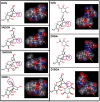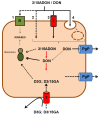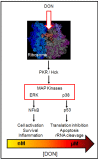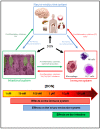From the gut to the brain: journey and pathophysiological effects of the food-associated trichothecene mycotoxin deoxynivalenol
- PMID: 23612752
- PMCID: PMC3705292
- DOI: 10.3390/toxins5040784
From the gut to the brain: journey and pathophysiological effects of the food-associated trichothecene mycotoxin deoxynivalenol
Abstract
Mycotoxins are fungal secondary metabolites contaminating food and causing toxicity to animals and humans. Among the various mycotoxins found in crops used for food and feed production, the trichothecene toxin deoxynivalenol (DON or vomitoxin) is one of the most prevalent and hazardous. In addition to native toxins, food also contains a large amount of plant and fungal derivatives of DON, including acetyl-DON (3 and 15ADON), glucoside-DON (D3G), and potentially animal derivatives such as glucuronide metabolites (D3 and D15GA) present in animal tissues (e.g., blood, muscle and liver tissue). The present review summarizes previous and very recent experimental data collected in vivo and in vitro regarding the transport, detoxification/metabolism and physiological impact of DON and its derivatives on intestinal, immune, endocrine and neurologic functions during their journey from the gut to the brain.
Figures









References
-
- Pitt J.I. Toxigenic fungi: Which are important? Med. Mycol. 2000;38:17–22. - PubMed
-
- Ueno Y., Nakajima M., Sakai K., Ishii K., Sato N. Comparative toxicology of trichothec mycotoxins: Inhibition of protein synthesis in animal cells. J. Biochem. 1973;74:285–296. - PubMed
-
- Rotter B.A., Prelusky D.B., Pestka J.J. Toxicology of deoxynivalenol (vomitoxin) J. Toxicol. Environ. Health. 1996;48:1–34. - PubMed
Publication types
MeSH terms
Substances
LinkOut - more resources
Full Text Sources
Other Literature Sources
Medical

